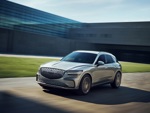By Andy Picton, specialist RV analyst at Glass’s
The new light commercial vehicle (LCV) market started 2025 down 20.5% down compared to January 2024, with 19,050 new LCVs registered. This is the second consecutive month of decline.
January saw demand fall across all sectors except those vans < 2.0 tonne GVW, where registrations increased 89.8%.
Vans > 2.0 - 2.5 tonnes GVW category recorded a 30.4% decline or 1,533 fewer units over the same period last year, whilst vans in the >2.5-3.5t GVW sector recorded a drop of 22.3%.
This sector registered 11,537 new units and continues to be the most popular representing 60.5% of all units registered during the month. The pick-up sector declined 6.5%.
January saw the Ford Transit Custom start the year strongly, along with its siblings the Ford Ranger in Second and the Ford Transit in third.
The Ford Transit Courier claimed tenth spot (511 units). Stellantis Pro One saw the Vauxhall Vivaro placed fourth, the Peugeot Partner sixth (686 units), the Citroen Berlingo seventh (650 units) and the Vauxhall Combo eighth (630 units).
The Mercedes-Benz Sprinter took fifth and the Renault Trafic finished nineth (518 units).
Top five LCV registrations
| YTD 2025 | January 2025 | January 2024 | |||
| Ford Transit Custom | 2,728 | Ford Transit Custom | 2,728 | Ford Transit Custom | 2,656 |
| Ford Ranger | 1,805 | Ford Ranger | 1,805 | Ford Transit | 1,898 |
| Ford Transit | 1,735 | Ford Transit | 1,735 | Vauxhall Vivaro | 1,612 |
| Vauxhall Vivaro | 770 | Ford Transit | 770 | Citroen Berlingo | 1,598 |
| Mercedes-Benz Sprinter | 712 | Mercedes-Benz Sprinter | 712 | Ford Ranger | 1,484 |
Electric van registrations
Battery electric vehicle (BEV) registrations to 3.5t GVW increased by 13% in January with 1,340 units registered compared to 1,186 units 12 months ago, representing a monthly market share of 7%.
Over half of all van models are now available as zero emission, but a lack of a van-specific infrastructure and effective Government support continues to blight the transition and reflects the huge challenge ahead in fast-tracking operators towards battery electric light commercial vehicles.
In this fast-changing sector, Stellantis have now confirmed that after 120 years, production at Luton is to cease in Q2 2025.
Machinery and process knowledge will move to Ellesmere Port with EV production of the medium (eK0) vans starting alongside the existing small electric vans in Q4 2026.
Battery electric LCV registrations up to 3.5t GVW
| Manufacturer: January 2025 |
Range: January 2025 |
Manufacturer YTD EV Sales |
YTD EV Regs as % of Overall Sales |
||||
| Volkswagen | 385 | Volkswagen ID Buzz Cargo | 385 | Volkswagen | 385 | Volkswagen | 21.3 |
| Ford | 340 | Ford E-Transit Custom | 268 | Ford | 340 | Mercedes-Benz | 10.1 |
| Mercedes-Benz | 117 | Mercedes-Benz eSprinter | 82 | Mercedes-Benz | 117 | Maxus | 9.9 |
| Peugeot | 100 | Ford E-Transit | 72 | Peugeot | 100 | Nissan | 8.4 |
| Citroen | 97 | Vauxhall Combo Electric | 71 | Citroen | 97 | Citroen | 8.3 |
Volkswagen accounted for 28.7% of all new BEVs registered up to 3.5t GVW in January. Ford finished second with 25.4% and Mercedes-Benz third (8.7%).
Peugeot placed fourth with 7.5% and Citroen fifth with 7.2%.
Places 6-10 were taken by Vauxhall with 92 units (6.9%), Renault 76 units (5.7%), Toyota 51 units (3.8%), Nissan 41 units (3.05%) and Maxus 37 units (2.8%).
By range, the Volkswagen ID Buzz Cargo accounted for 28.7% of all new electric vans registered in the month.
Positions six-10 were filled by the Peugeot e-Expert (64 units – 4.8%), the Citroen e-Berlingo (60 units – 4.5%), the Toyota Proace City Electric (48 units – 3.6%), the Peugeot e-Partner (33 units - 2.5%) and the Renault Kangoo E-Tech (32 units - 2.4%).
An additional 124 BEVs from Fiat, Ford, Iveco, Maxus, Mercedes-Benz, Peugeot and Toyota, (116 units – January 2024) between 3.5t-4.25t GVW, were registered as part of the Vehicle Emissions Trading Scheme (VETS) and contributed towards a monthly market share of 0.6%.
A total of 1,464 units and a market share of 7.6% were registered during the month compared to 1,302 last January (5.4%).
The plug-In hybrid van market saw Ford and Toyota register 549 units between them during January. Ford registered 367 Transit Custom PHEVs and 25 Transit Connect PHEVs, whilst Toyota registered 157 Corolla Commercials.
Used LCV market overview
Attendance at used LCV auctions has been positive during January with good turn outs at physical sales and many more logging in online.
In an ongoing theme, there remains intense competition for clean low mileage vehicles, driving up market prices. Older, higher mileage vehicles, exhibiting more damage and in need of remedial work, were attracting fewer bids and selling at below expected levels.
The supply and demand of used stock to the wholesale market does seem to be well matched at present, resulting in stable market prices.
These are expected to continue throughout Q1 but may come under pressure as we move through Q2.
Lower new LCV registration figures, during covid-hit 2022, is likely to result in a shortage of three-year-old vehicles during the second half of the year and into 2026. Although stock levels may be impacted, values should remain firm.
January in detail
Average prices paid at auction increased for the second consecutive month, rising last month over 10%.
The average age of stock in January was seven months younger than that in December, falling from 80.3 months to 73.3 months and was 4.7 months younger than a year ago.
Average mileage increased by 0.4% to 80,397 miles during the month but remained 2.1% lower than January 2024.
Of the vehicles sold at auction in December, 82% were Euro 6 with an average age of 57 months and average mileage of 71,564 miles (72,579 miles in December).
Sales of used electric vans fell 0.2% to 0.7% of the overall market. The average age of these vehicles dropped to 56.9 months from 70.7 months, with average mileage of 27,619 miles up from 27,234 miles.
Euro 5 stock made up the remaining 17.3% of sales, falling 3.5% on the previous period.
Medium sized van sales accounted for 35.9% of the overall total. Large vans 27.5% and small vans 25.5%.
Volumes of 4x4 Pickup sales accounted for only 11.1% but recorded the highest average sale price at £13,859 - up 10.2% on December.
Large vans covered more distance than any other vehicle type at an average of 92,760 miles. This was an increase of nearly 5,600 miles on the previous month and 1,775 miles annually.
Overall first-time conversion rates increased for the ninth month in a row to 84.5%. This is a 0.7% increase on December and an 8.6% increase on January 2024.
Broken down, the best conversion rate was achieved in the small van sector at 85.2% (up 0.4%), followed by the medium van sector at 85.1% (up 2.2%) and the large van sector at 84.1% (up 2.8%).
A conversion rate of 81.5% (down 3.1%) in the 4x4 pick-up sector returned the lowest.
Used vehicles observed for sale in the retail market last month increased by 0.95% to just over 44,500 units. Of these, 92.9% were diesel models, 2.2% were petrol, 0.6% were PHEV and 4.1% were BEVs.
37.5% of all vehicles on sale were valued at £20,000 or more, while 35.6% were on sale for between £20,000 and £10,000.
Those vehicles on sale between £10,000 - £5,000 made up 21.4% of the overall market, whilst 5.5% were on sale for less than £5,000.
White vehicles make up just under half of all vans on sale at 49.8%, followed by grey at 16% and silver at 10.3%.
Average age fell by a month to 57 months whilst average mileage fell by 3.5% to just over 56,000 miles.


















Login to comment
Comments
No comments have been made yet.